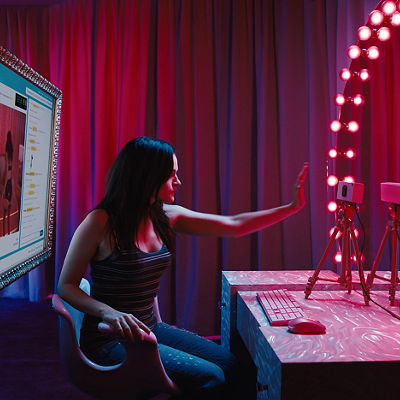In Rock Hudson, Rappaport imagined a kind of limbo where Hudson (played by actor Eric Farr) could review the movies of his life long after his death. Rather than deny his homosexuality, as the real Hudson did throughout his career as a Hollywood leading man, Rappaport's Hudson frankly admits that his on-screen image was a complete sham. But he doesn't stop there. While offering caustic commentary on clips from his movies, this Hudson repeatedly expresses amazement that audiences were unable -- or, more likely, unwilling -- to recognize signs of his off-camera, carefully closeted lifestyle. "It's not like it wasn't up there on the screen, if you watched carefully," Hudson says. The best evidence: Pillow Talk, a frothy 1959 comedy in which Hudson, a gay actor who pretended to be straight, plays a straight man who pretends to be gay.
Rock Hudson relies a bit too heavily on snide sarcasm, to the point that, perhaps inadvertently, it makes a strong case for gay actors to forever remain in the closet. (Each time Rappaport's Hudson makes a rude comment about the real Hudson's misadventures as an on-screen lady's man, you can't help thinking: wouldn't audiences say the same things about any contemporary actor who tried to play a straight character after publicly acknowledging his homosexuality?) Jean Seberg takes a much more sympathetic approach to its subject, and uses humor to provide sharp insights rather than cheap laughs. Think of it as the next step in the progression of "fictional autobiography" from eccentric stunt to genuine art form.
In the title role, Rappaport cast Mary Beth Hurt, an actress who was born in Marshalltown, Iowa, the birthplace of the real Jean Seberg. Once again, Rappaport offers his subject as a kind of ghostly master of ceremonies for a film-clip retrospective. This time, however, the goal is appreciably different. In Jean Seberg, Rappaport wants to use the tragic story of a relatively obscure, almost-forgotten actress as the jumping-off point for a freewheeling meditation on the nature of cinema in general, and the depiction of women on-screen in particular.
Seberg first attracted public attention in 1957, when, while still a teenager, she won a nationwide talent search and the lead role in Otto Preminger's film of George Bernard Shaw's Saint Joan. "People magazine didn't exist then," Hurt (as Seberg) says with just the right balance of girlish pride and bitter self-awareness. "But if it did, I would have been on the cover." Unfortunately, Saint Joan was a resounding flop. (With good reason. As Hurt's Seberg says, "Who would follow this drum majorette into battle?") And when Preminger stubbornly cast her in a second lead role, in 1958's Bonjour Tristesse, that movie flopped, too. You've heard of overnight successes? In 1958, Seberg appeared to be an overnight failure.
But then a curious thing happened: French film critic Jean-Luc Godard was greatly impressed by Seberg's performance in Bonjour Tristesse. He was particularly taken with the film's final scene, a long, continuous take in which Seberg dances with an unseen partner, all the while staring blankly at the camera. Godard viewed her face as a tabula rasa on which audiences could project all manner of meanings and motivations. ("I was the first actress," Hurt's Seberg says, "who returned the hard stare of the camera's lens.") So he offered Seberg the lead female role as a duplicitous gamin in his first directorial effort, Breathless. The movie made her a pop-culture icon. Nothing else she ever did, on-screen or off, had quite the same impact.
Mind you, Seberg generated quite a few headlines before her death by suicide in 1979. But the news she made was seldom good. She supported the Black Panthers in Los Angeles, which led to her being targeted for a smear campaign directed by J. Edgar Hoover himself. (By the way, this is documented fact, not paranoid fantasy.) She had an affair with Clint Eastwood during the filming of Paint Your Wagon, a disaster of Saint Joan proportions. And she played a frigid nymphomaniac in the overheated Birds in Peru, the first movie directed by her second husband, novelist Romain Gary. Jean Seberg views Birds in Peru in the context of other movies by directors who have cast their loved ones as whores, bimbos or prostitutes. Movies such as Barbarella, in which Roger Vadim turned Jane Fonda, then his wife, into an intergalactic sexpot. All of which prompts Seberg to wonder, "What is it with these guys who offer their wives and mistresses on-screen for the sexual fantasies of millions of unseen men in darkened theaters?"
And why do those wives and mistresses agree to take part in such degrading escapades? "Don't ask why," Hurt's Seberg says. "I was a good girl, and I did as I was told." That, Rappaport implies, explains a lot about the way women have been portrayed in movies ever since people started making movies.
It's worth noting, incidentally, that neither Rock Hudson's Home Movies nor From the Journals of Jean Seberg has been made available to Houston audiences in traditional commercial venues. Rock Hudson had its only local showcase during two nights in June 1993 at the Museum of Fine Arts. Jean Seberg will be on view at 7:30 p.m. Friday through Sunday, October 46, at the Rice University Media Center. (The new Rappaport film will be shown each evening on a double bill with Robert Rossen's Lilith, the 1963 drama in which Seberg is a seductive mental patient who drives her therapist -- played by, no kidding, Warren Beatty -- to the point of madness.) In an age when even so-called art houses must keep a close eye on the bottom line while programming "alternative" fare, it's reassuring to know that venturesome moviegoers can still rely on two nonprofit outlets for cutting-edge cinema.
From the Journals of Jean Seberg.
Directed by Michael Rappaport. With Mary Beth Hurt.
Not rated.
97 minutes.





